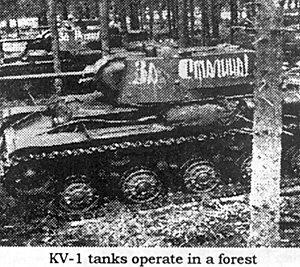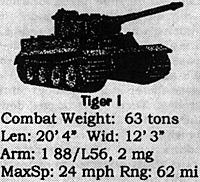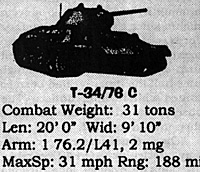
The defender will often find it expedient to attack the flank of an enemy penetration with the objective of cutting off and destroying the hostile forces that have broken through. Such tactics are effective only when a secure shoulder provides the defender with a springboard for an attack which is launched straight across the gap to the other shoulder, or when a natural obstacle, such as a large body of water or a swamp, serves as an anvil against which he can crush the attacker.
An effective flank attack requires a balanced force with adequate striking power whose strength need not necessarily exceed one- third of the total enemy forces committed in the breakthrough. The more powerful and mobile the force, the quicker the defender will attain his objective. Unsupported infantry is incapable of mounting a successful flank attack against an armored penetration. In such a situation infantry must always be supported by strong assault gun and armored units as wen as sizable antitank forces.
The defender who attacks the flank of an enemy penetration runs the risk of exposing his own flank and must therefore take this factor into account when he plans the counterattack. The danger is usually less serious than anticipated because, during the initial stages of the break- through, the attacker usually commits his forces almost exclusively along the axis of advance without giving much attention to his flanks. These rush tactics are practical, however, only so long as the defender has neither the means nor the opportunity for immediate, effective counteraction.
During their invasion of Russia in 1941, for instance, the Germans did not present the Russians with any such opening. On the other hand, during the Russian counteroffensives in 1942, the German command always had strong armored forces at its disp it inadvisable for the enemy to be careless in exposing his flanks.
Bitter experience was to teach the Russian that flanks must be protected until he finally made them so tank-proof that they could only be overpowered with heavy casualties. For this reason the German flank attacks gradually lost their sting after 1943 and were more often repulsed.
Flank attacks are particularly effective when employed to eliminate hostile river crossings. The forces which cross first can usually be shattered or wiped out without too much difficulty because they rarely have adequate defensive protection. This happened, for instance, along the Teterev in December 1943. The defender will find it much more difficult, well-nigh impossible, to eliminate a strongly fortified enemy bridgehead which has adequate fire support from the far bank of the river.
At the beginning of April 1944, the Germans launched a attack which proved very effective in remedying a precarious situation. After heavy winter fighting in eastern Galicia and Podolia, the Fourth Panzer Army, with three corps, was on a line extending from Kovel in the north, through Brody, to Berezhany in the south (Map 8). The Russian encirclement of Brody was imminent.
There was a gap between that town and the army's left wing, and the army right flank was exposed. The so-called fortress Ternopol, 18 miles to the front of the south wing, had been encircled for ten clays. The First Panzer Army, forming a roving pocket, was moving north of the Dnestr River toward the gap on Fourth Panzer Army's southern flank. Strong Russian forces were driving westward past the pocket on both sides of the river.
Although the over-all situation was far from satisfactory, the Fourth Panzer Army had at least stopped its retrograde movement. The army was intact after many critical battles and had inflicted heavy losses upon the enemy during the winter. Despite evident battle weariness, the Russians continued their attempts to take Brody in order to gain a route to Lvov. They did succeed in encircling the city on several occasions. The encirclements were broken each time by the provisional armored Task Force Friebe, made up of one battalion of Tigers and one of Panthers.
This task force, augmented by a rocket projector brigade equipped with 900 late-type launchers, destroyed the enemy while he was still in his assembly area preparing for the final all-out attack. The Russians abandoned the siege of Brody and, in a most unusual change of tactics, used their newly arrived forces to form a continuous front line opposite the army center. The XIII Infantry Corps followed suit and linked up with the XLII Infantry Corps to the north, thus closing the gap north of Brody. The armored task force was now available for other missions.
The army's exposed right flank was under light attack. The Russians captured a few villages, but they were promptly retaken by local reserves supported by an armored battalion which moved freely along the flank. The army front was intact and the southern flank, though exposed, was secure.
Still, the Russian forces which had bypassed the roving pocket continued their westward drive. Their armored spearheads south of the Dnestr entered Stanislav, and those to the north of the river approached the fortified area around the Galich bridgehead. Quickly gathered German infantry, together with advance elements of the Hungarian First Army, which was assembling in the Stamalav-Nadvornaya area, drove the enemy out of Stanislav after street fighting. North of the river, however, the enemy, hampered only by muddy terrain, reached the Zlota Lipa valley. His axis of advance pointed toward the Drohobyez oil fields.
 The forward elements of the forces in the pocket had by now
reached the Chortkuv area. The Fourth Panzer Army was given the
mission of relieving the First Panzer Army by a flank attack, and it
received strong reinforcements for the execution of this task. The flank
attack was to be launched to the southeast from Berezhany, while a
secondary thrust to the Dnestr was to pinch off and destroy the Russian
infantry divisions which had penetrated as far as the Galich area.
The forward elements of the forces in the pocket had by now
reached the Chortkuv area. The Fourth Panzer Army was given the
mission of relieving the First Panzer Army by a flank attack, and it
received strong reinforcements for the execution of this task. The flank
attack was to be launched to the southeast from Berezhany, while a
secondary thrust to the Dnestr was to pinch off and destroy the Russian
infantry divisions which had penetrated as far as the Galich area.
As a preliminary step, the first elements of the 100th Light Infantry Division, detraining in the army rear area, were ordered to capture the terrain south of Berezhany. Elements of another infantry division were to take the area south of Rogatin. Both of these operations were designed to secure the unloading of II SS Panzer Corps, which had been transferred from Italy. Within a few days after detraining the corps was ready to jump off. Aware of the threat to their flank, the Russians used all their available air power to harass the assembly of the German forces which were restricted to the only two usab1e roads in the area. This enemy interference, however, was negligible compared to the difficulties presented by the muddy terrain.
The 100th Light Infantry Division was to clear the way for the decisive thrust, with the panzer corps following close behind. The only available all-weather road permitting major mechanized movements led via Podgaytse to Buchach. The infantry had the mission of capturing heavily defended Podgaytse to open the road for the Panzer thrust. Hardly had the enemy screening force been dislodged from the wooded heights south of Berezhany, when the infantry ran into huge snowdrifts which covered the entire road to a depth of several feet along 200- to 500-yard stretches. it was impossible to bypass these obstacles because of the rugged, snow-covered terrain on both sides of the road. Security guards were posted and the combat troops, equipped only with entrenching tools and a few locally procured shovels, began to clear the snow.
After several hours of steady work, a single lane was opened and around noon it was possible to move up the artillery and tanks which were essential for the impending operation against Podgaytse.
Despite the delay, the infantry took the strongly organized high ground in front of Podgaytse the same day. The division's Tiger battalion knocked out the T34s and antitank gun positions which defended the entrance to the town, but in so doing completely blocked its own advance.
The main entrance alone was clogged by sixteen disabled Russian tanks and, as the infantry edged forward in house-to-house fighting, the wrecks were towed off, pushed aside, or blown up. By late evening the Tigers had thrust across the town, knocking out thirty-six additional tanks in their advance. The infantry mopped up during the night and on the next morning turned eastward toward the Strypa River to secure the left flank of the panzer corps and to make way for its advance.
The 10th SS Panzer Division now took the lead, with 100 tanks spearheading the movement. At the southern edge of Podgaytse the division ran into strong resistance from skillfully concealed antitank guns which were too well entrenched to be attacked frontally and could not be bypassed because of the deep water ditches, ravines, and swamps on both sides of the road. After close reconnaissance, the guns were finally knocked out one by one with concentrated panzer and artillery fire. The way cleared, the tanks rolled forward.
To avoid further delay, the division commander decided to drive cross-country to Buchach, but the route taken for a short cut proved to be a quagmire. Only the division commander with five lead tanks got through. Although he was able to establish contact with the spearheads of the First Panzer Army, this acluevement served no practical purpose as long as the highway from Podgaytse to Buchach was still in enemy hands. The hasty decision to leave this highway delayed the operation and cut off the division commander from his troops. Their tanks bogged down, the panzer troops, fighting as infantry under the corps commander, undertook the clearance of the highway.
Hostile antitank fire interferred with their advance, and the Soviets offered strong resistance in the villages along the road. But, subjected to increasing pressure both from the panzer corps and the infantry division approaching from the Galich area, their efforts were in vain. That evening, near the bend of the road west of Buchach, the Russian infantry divisions fleeing eastward along the Dnestr were blocked off, hurled against the river, and destroyed with the help of newly arrived infantry forces. The attack units regrouped and then turned eastward.
 On 5 April Buchach was reached, and the axis of withdrawal of
the encircled army was cleared. The Russians did not readily yield the
prize which was being wrung from their grasp. In fierce pursuit they tried
to cross the swollen Strypa to cut the escape artery, but they were no
match for the liberating forces. Whenever they got across the river, they
were immediately thrown back.
On 5 April Buchach was reached, and the axis of withdrawal of
the encircled army was cleared. The Russians did not readily yield the
prize which was being wrung from their grasp. In fierce pursuit they tried
to cross the swollen Strypa to cut the escape artery, but they were no
match for the liberating forces. Whenever they got across the river, they
were immediately thrown back.
By mid-April the right wing of the Fourth Panzer Army had deployed behind the Strypa, and the front, anchored on the Dnestr to the south, included a bridgehead across the Strypa opposite Buchach. On this line fixed positions were organized. The onjective of the flank attack-- stabilization of the front in eastern Galicia was attained with the liberation of the First Panzer Army from encirclement and its reintegration into the German defense system.
20-mile Gap
In another instance, hostile armored forces opened a 20-mile gap through which the Russians poured reinforcements. The German command wanted to close the breach by a flank attack but had only one panzer division for this purpose. The division was much too weak for this mission, all the more since the enemy had committed strong forces to widen the gap and was protecting his southern flank with powerful armored and antitank units.
The operation was therefore divided into several phases. As an initial step the crumbling shoulder south of the gap was strengthened, and then a preliminary panzer attack narrowed the breach to ten miles. Immediately after its replacement by infantry units, the panzer division was ready for the main phase of the operation -- the closing of the gap. In a surprise night attack against the enemy flank, the mechanized infantry overcame the tank and antitank cover, and the German tanks, immediately following, succeeded in closing the gap. Furious enemy attacks against the newly established defense line were repelled, but now the northern anchor, held by a recently activated division, gave way in the face of heavily mounting pressure.
Finally, this danger was eliminated by the timely arrival of reinforcements. This example clearly demonstrates the effectiveness of a well-executed flank attack even though it may have to be carried out with comparatively weak tank forces. The importance of securing the shoulders at the base of a break-through is only too obvious.
The flank attack is very frequently used in local counterattacks and is an integral part of many large-scale defensive operations. A break- through on a very wide frontage by overwhelmingly superior armor cannot be eliminated by a flank attack even though strong tank forces may be available to the defender, because the attacker usually protects his interior flanks with adequate armor and antitank gun fronts. But even if the flank attack should surmount this obstacle, the attacker still has sufficient time to shift strong tank units from his main effort to the threatened interior flank in order to eliminate the danger.
Under the most favorable circumstances, the defender's armored units may be able to divert the attacker's main force by compelling him to establish a new defense line on his flank. This happened west of Kiev in November 1943 when the Germans first succeeded in thwarting the enemy's attack plan, but later saw their own plans frustrated. The result was an extension of their own front line which tied down the German reserves committed in the flank attack. Moreover, by leaving their own flank open, the Germans encouraged the Russians to press their attacks in that direction.
Frequently, the threat of a flank attack by armored forces Will alarm the attacker so much that he will halt his offensive in order to avoid the annihilation of those of his forces which have broken through. He will be especially apprehensive if, only shortly before, he has suffered a severe blow by a flank attack or some other armored thrust. During the German relief thrust toward Stalingrad, for instance, panzer forces turned against the flank of the advancing Russian infantry, who fled panic- stricken. This was not surprising since earlier that month a Russian cavalry corps had been annihilated by a flank attack of a strong panzer division at Pokhlebin on the Aksay River and two Russian infantry divisions had been routed north of the river by similar methods.
German Active Defense Against Russian Breakthroughs
German Active Defense Against Russian Breakthroughs Part 2
-
Introduction
Defensive Pincers
Defense in Place with Mobile Reserves
Position Defense in Strong Points and Improvised Fortresses
Back to Table of Contents -- Combat Simulation Vol 2 No. 1
Back to Combat Simulation List of Issues
Back to MagWeb Magazine List
© Copyright 1995 by Mike Vogell and Phoenix Military Simulations.
This article appears in MagWeb (Magazine Web) on the Internet World Wide Web.
Other military history articles and gaming articles are available at http://www.magweb.com